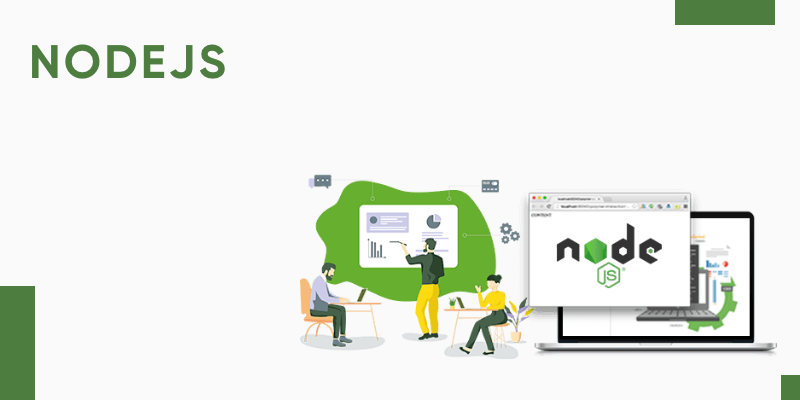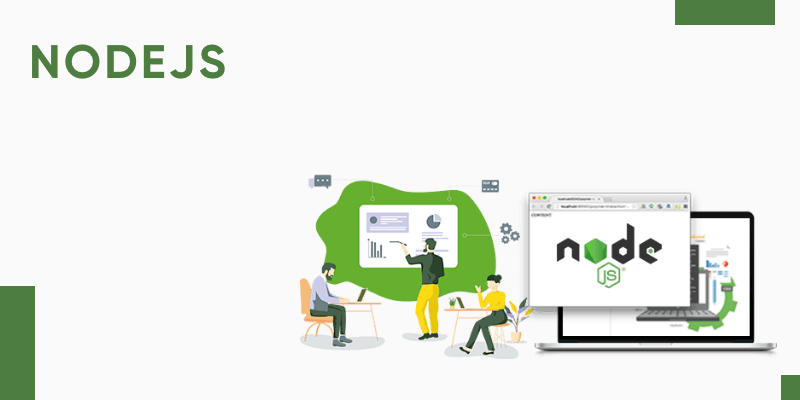It’s essential to have a reliable backend for your applications to run smoothly. However, selecting the best technology stack to meet this requirement is problematic. You’ll need tools to build and scale data management, APIs, and less-user-facing code. For several companies, NodeJS was the platform of choice for backend development. Today, this situation has altered, with major corporations such as Uber shifting to Google’s Golang programming language. Here, we have compared NodeJs vs Golang for you.
Golang has garnered a lot of popularity in the backend development world since its debut in 2009. On the other hand, NodeJS developed simultaneously, has found popularity among programmers due to its cross-platform capabilities. With all of this in mind, how can you choose and select the one that best suits your business requirements? This blog will compare Golang with NodeJS to answer this topic in-depth and assist you in making the best decision for your forthcoming 2022 projects. But first, let’s go through some of the basics.
What Is The Use Of NodeJS?
Experts recommend NodeJS, JavaScript Package Manager (JSPM), Node Package Manager (NPM), and others for package management via browser. It’s used to make back-end web apps and development tools like gulp or grunt for task running and automation, webpack for module management, etc. Other applications could involve the creation of chatbots and neural networks.
Introduction To Node Js

NodeJS is an open-source JavaScript runtime environment that was created to fulfill the needs of complicated, highly scalable network applications. Based on Google Chrome’s V8 JavaScript engine, this environment allows you to develop programs operating on various platforms, including Linux, macOS, and Windows. NodeJS is written in JavaScript, allowing programmers to use a single language to execute server-side and client-side coding.
JavaScript has successfully grown over the years with NodeJS to accomplish full-stack development — not just for the front end but also for the back end. This makes it one of the most popular event-driven platforms for developing web applications. Not to mention that some of the most well-known firms in the world, including Netflix, Linkedin, Trello, PayPal, and Medium, use NodeJS.
Now that we’ve covered the basics of NodeJS let’s look at its pros and cons:
Pros
- NodeJS is widely recognized as one of the best platforms for developing scalable apps.
- You can utilize NodeJS to improve your backend capabilities while simultaneously speeding up your frontend capabilities.
- With JSON support, NodeJS makes it simple for developers to create RESTful APIs for NoSQL databases.
- It has a strong, active, and enthusiastic development community that helps it keep up with the times.
- NodeJS can be used in conjunction with a microservices architecture, making it simple to add new features to your app.
Its minimal weight characteristic allows your developers to accelerate the development process and launch apps more quickly and efficiently.
Cons
- It is incapable of handling complex computational tasks.
- Its recurrent, backward-incompatible API changes necessitate extensive code changes.
- Because Node JS has a small standard library, developers must rely on many third-party libraries.
- The market is unable to meet the requirements for NodeJS developers.
Introduction To Golang
Golang, also known as Go, is an open-source, statistically typed programming language created by Google to speed up the delivery of software solutions. It’s a cross-platform, multifunctional language highly recommended for web development, just like NodeJS. It is developer-friendly because it blends the strengths of other languages and overcomes their limits to tackle current and future programming difficulties.
It has a simple yet straightforward syntax that allows you to produce legible and maintainable code. Go is also a structural language that combines the security and speed advantages of C++ /C. It’s based on Python’s speed-of-development ideas, making it a popular choice among programmers worldwide. Its cutting-edge programming tools make developing code more efficient and accessible. Numerous tech giants like Intel, Dropbox, Kubernetes, Docker, and Heroku use this language. Let’s look into the pros and cons of Golang now:
What Is Golang Used For?

Golang is a programming language used to create various applications, particularly for system programming. Developers widely use it to design high-end modular systems focusing on speed, security, and other large-scale distributed systems. It’s also recognized for being commonly used in highly scalable network applications and servers. The language is also helpful in developing cloud-based interfaces and associated tasks. Live application platforms, extensive data/machine learning programs, and microservices are some of the other Golang use cases.
Pros
- Static typing underpins Golang, allowing the compiler to quickly uncover entire classes of errors.
- The language supports structural typing (also known as duck typing), which means that any structure can satisfy an interface as long as it includes the required methods. This aids in the decoupling of coding dependencies and the writing of more testable programs.
- Golang contains a sizeable standard library and concrete packages with built-in primitive-type functionality that is simple to use
- This standard library also includes testing support, removing any further reliance.
- Garbage collection makes memory management in Go much easier
- Concurrent programming becomes much easier, and you can easily create a lightweight thread, known as a ‘goroutine,’ and interact with it via a ‘channel.'
Cons
- The language lacks generics, resulting in a copy-paste code style for specific solutions.
- Unlike Java, Go does not have a tunable garbage collector
- As a relatively new language, the market cannot efficiently meet Golang developers' needs.
Discussing the pros and cons is not the only factor that can assist you in making the best decision. As a result, the following section highlights the key differences between the two while emphasizing their uniqueness.
Comparison Between NodeJS Vs Golang
Go is a programming language used to create various applications, particularly for system programming. Developers widely use it to design high-end modular systems focusing on speed, security, and other large-scale distributed systems. It’s also recognized for being commonly used in highly scalable network applications and servers. The language is also helpful in developing cloud-based interfaces and associated tasks. Live application platforms, extensive data/machine learning programs, and microservices are some of the other Golang use cases.
Performance
You might be looking for health apps to help you stay fit during the pandemic and eliminate unhealthy behaviors. That’s why you need to play it safe and opt for an application that utilizes strategies that work perfectly.
When looking for a health app, you must look for evidence-based strategies, such as rewards, social support, self-monitoring, push notifications or cues, and goal setting. If you come across strategies within an app, that’s the right one.
Benchmarks
You may figure out which tool or language is best by running through various jobs or algorithms and calculating the time, speed, and other factors that every language requires. This section will look at an example of Nodejs vs Golang performance in a benchmark task. Experiment with various techniques and algorithms for computer languages. We can see from the statistics that Golang uses less time, memory, and CPU to complete tasks than Node.js.
Difficulty Level
Because it leverages JavaScript, which is widespread among all types of developers and the most frequently used programming language globally, Nodejs is easier to learn than Golang. Furthermore, because of the amount of Node.js courses and content available online, Node.js will be easier to understand than Golang if a developer is unfamiliar with JavaScript.
Developers must master Golang’s procedures, concepts, rules, pointers, strict typing, interfaces, coroutines, and other features. The learning curve for Golang developers is often steeper. Above all, Golang is strictly a backend programming language. As a result, you’ll need to hire a front-end developer on your own. When comparing Node.js to Golang, it’s evident that Node.js has a lower learning curve.
Community
Open-source projects are notable for the enormous number of developers who contribute daily and the large community that supports them. Both Nodejs and Golang are open-source projects with significant development communities and support. On the one hand, Node.js is a more developed framework with a larger and more welcoming community. The Node.js Foundation oversees the security and long-term support (LTS) plan for more excellent Node.js stability, facilitating wider adoption.
GoDaddy, Intel, IBM, Microsoft, PayPal, and NodeSource are members of the Node.js Foundation and Node+JS Interactive, where programmers reveal new upgrades and updates to Node.js. Node.js has 80,300 Github stars and over one billion downloads as of this writing. At the same time, Golang has a smaller but rapidly developing community. Google’s backing for Go and hosting of the GopherCon, an annual gathering of Go developers worldwide to discuss new prospects and changes, provide compelling reasons to switch to Golang.
At the time of writing, Golang had 87,600 Github Stars, higher than Node.js, and many contributors worldwide. Because Node.js is a JavaScript engine, and JavaScript is more popular, it is evident that it has more community strength than Golang.
Development Tools
Everyone will agree that having libraries and tools available for each work or project saves time and money during development. Regarding the number of development tools available, Node.js reigns supreme. In the JavaScript ecosystem, tools exist for almost any task you can think of, from performing a simple task to accomplishing sophisticated tasks.
NPM alone provides over 800,000 ready-made tools for any circumstance, with many more on the edge of becoming functional. Golang is a newcomer to the backend development scene, and while it has a lot of helpful capabilities, it doesn’t have as many as Node.js.
This comparison shows that Node.js has more development tools than Golang because it can be used for both the front and back end.
Salary and Availability of Developers
Because Go is a new language, it can take a lot of work to find developers, but it is one of the most promising, with a bright future.
Because of its JavaScript ecosystem, Node.js is already highly popular. Finding Node.js engineers and expertise is considerably more manageable for many development projects.
Let’s look at the StackOverflow Survey 2020 for salaries by technology. Because of the scarcity produced as a new and promising programming language, Golang pays very well:
Golang pays 74,000 USD, compared to 53,000 USD for Node.js. Furthermore, Node.js employment is more plentiful and in great demand than Golang jobs. Because Node.js is a JavaScript engine, job availability for JavaScript is already excellent, making Node.js extremely profitable.
In the United States, a parallel may also exist. The comparison shows that Node.js has more engineers and job openings than Golang, yet Golang pays more.
Companies And Apps Using Node.Js
The following is a list of companies and applications that actively use Node.js on their servers.
- Netflix
- Walmart
- Trello
- Uber
- PayPal
- Medium
- eBay
- NASA
Companies And Apps Using Golang
The following is a list of companies and applications that actively use Golang on their servers:
- Uber
- Twitch
- Dailymotion
- SendGrid
- Dropbox
- SoundCloud
Conclusion
Based on the analysis above, it’s difficult to say which technology is superior. We’ve tried to provide insights into which technology will best suit your project or align with your company’s culture and processes. It relies on your background when determining which tool is best. If you’re a skilled JavaScript programmer, Node.js makes perfect sense.
Node is in a language you already know and is part of a large community you’re already a part of! However, there is a potential that you will need to learn a dedicated, high-performance back-end language later on.
If you’re unfamiliar with JavaScript and want to add a powerful server-side language to your toolkit, Golang is a must-have. It’s young and fresh, but it’s growing every day, and now is an exciting time to join the community and thrive in the employment market, as demand is strong, but supply is low.
FAQs
Which companies use Node.js?
Node.js is widely popular and global names like Netflix, LinkedIn, PayPal, Trello, eBay, Medium, etc use it.
Which is faster between Node.js and Golang?
As Golang is based on C/C++, it is much faster and lighter than Node.js.



